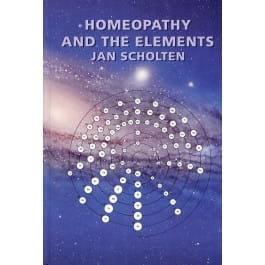Jan Scholten's second book is about the physical elements, also called atoms, the basic building blocks of all matter on earth. They are depicted in the famous Periodic table of Mendelejev, which most people will know from chemistry classes in high school.
The elements are presented in rows and columns, which reflects their relationship to each other. Elements were put in the same column because they were very similar. Jan Scholten discovered that this resemblance is also the case for the remedy pictures of those elements. Remedies in the same column or in the same row have a similar remedy picture.
The rows reflect the themes of life:
- Row 1- Hydrogen series; Unborn.
- Row 2 - Carbon series; Individuality, Child.
- Row 3 - Silicium series, Relations, Puberty.
- Row 4 - Iron series; Work, Adulthood.
- Row 5 - Silver series; Creativity, Middle age.
- Row 6 - Gold series; Leader, Ripe age.
- Row 7 - Uranium series; Retirement, Elder.
The columns reflect the way a theme is handled. The 18 columns are 18 stages in a development, going from impulse and start, developing further to a culmination and then decline. They represent the universal theme of life coming to blossom and then disappearing again. The periodic system is thus seen as a symbol of life, starting with Hydrogen and ending with the heavy, radioactive elements. The principles of group analysis, classification, are applied in this book to all the elements with enormous success. Pictures of remedies, then unknown in homeopathy were predicted and applied with success. It made the Mineral kingdom understandable homeopathically.
- Author: Jan Scholten
- ISBN: 9789074817059
- 880 pages
- Hardback
- Published in 2007
- Printed in Netherlands
Reprinted with the permission of The Society of Homeopaths, from 'The Homeopath' Journal, Spring 1997 edition. Reviewed by Robin Logan.
This book is a development of the ideas first presented in Homoeopathy and the Minerals five years ago. Scholten's latest approach is based on the Periodic Table with its series joined up and bent round into a spiral. The circles within the spiral represent the rows of the Table and each has a specific theme. Elements represent 'stages of development' of the theme of the series - there are 18 stages in all. Thus the theme of the Hydrogen series is 'being', that of the Carbon series is 'I', Silicium 'other' and so on. Stage one has the title 'beginning', stage two 'finding a space', stage 3 'comparing' etc. Every idea is expanded on so that the reader is given a detailed description of the characteristics of each of the series and stages.
The bulk of the book consists of detailed materia medica based on the above concepts, each remedy having an 'essence'. So Lactic acid becomes 'the girl that never grows up', Yttrium is 'exploring your creative abilities', Magnesium silicatum 'a brave image'. Most remedy descriptions have case examples attached. These ideas are very appealing and many practitioners keen on expanding their knowledge of materia medica and solving difficult cases are taking these concepts on board.
In the 'Epilogue' and 'Sources of Remedy Pictures' chapters Jan Scholten addresses some important reservations one might have about his new methods. These include the question of how often these strange new remedies are appropriate and how reliable their pictures as presented are. It is clear from what he says that he is a deep thinking, sincere and conscientious practitioner. However, I feel uneasy about a lot of the content of the book; there are far too many a-priori ideas in my opinion. What may be useful concepts in their essence begin to stretch the imagination once they are elaborated on and broken down into more detailed subheadings. Case examples are given but it seems to me that it would take dozens of cured cases to arrive at the detailed materia medica presented here. One or two cases in which the remedy concerned may have only been part of the process is not adequate to support radical, detailed new materia medica. As a profession we must be unique in the extent to which we unquestioningly take on new ideas and there are good and not so good consequences of doing that.
Some of my reservations come from my own experience of using some of the remedies discussed. Manganum and Muriatic acid are two examples of remedies that described in Jan's terms do not in any way resemble my patients who responded deeply to those remedies when prescribed on the basis of repertorisation of 'minimum symptoms of maximum value'.
An enormous amount of time and energy must have gone into this book. It is densely packed with new ideas. When I consider that Jan has been practising for the same length of time as me I feel particularly awe-inspired by the extent of his knowledge and originality of his insights. He is obviously a thinking homoeopath and I applaud him for that. I recommend the book's use so that we can collectively 'separate the wheat from the chaff and discover what is going to be of lasting value amongst the vast amount of information presented.

